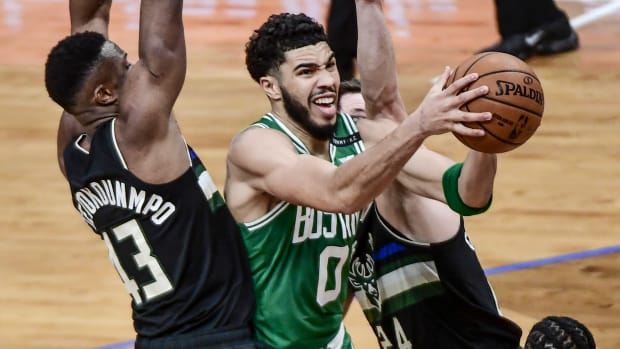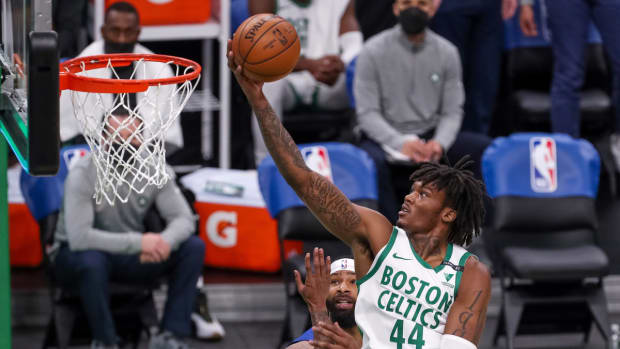Last year’s conference finalists are under .500. Why? There are plenty of issues. Is it all fixable? Maybe.
What’s been most interesting about the Celtics this season is how distinct they feel inside the Brad Stevens era, in mostly frustrating ways. The commonalities are people, not style or aesthetic. An example: Their three-point rate is slightly below what it was four years ago. Only three other teams can say the same thing, and two (the Rockets and Cavaliers) have completely melted down since. (The Ben Simmons-less Sixers are the other.)
The Celtics don’t aggregate their hyper-talented individual parts on offense and are without any identity—or eagerness to discover one—on defense. They’re below average on that end for the first time since Stevens was hired. As is the case whenever a team struggles, past decisions made by the front office that were no-brainers in real time have become sliding door moments argued over by unhappy fans.
But the team we’ll see from this point forward is shaped differently than the disappointing club that was constantly searching for a new rock bottom before the trade deadline. That doesn’t mean they’ll be better or worse, but identical isn’t an option here. (We’ve already seen a change in that three-point rate, where Boston ranked 20th before the All-Star break—with 37.2% of their shots coming behind the arc—and sixth since. They’re up to 44.2% in those 12 games.) The bench is less ambiguous, but new holes need to be filled by less experienced players, particularly at the five. As questions abound, here are a few that try to cover the most important themes seen so far and more importantly, everything that may still be to come.

Can the Celtics make a deep run?
Boston has a worse record than the Knicks and the Hornets. But even though they’re 28th in win differential (meaning their point differential indicates they should have 3.2 more wins than they do), they won’t be favored in the first round, let alone be expected to win multiple playoff series.
But if you’re of the mind that some of the predictive data we normally use to analyze the regular season is especially useless right now—marred by all that the pandemic has wrought on players, coaches, training staffs, referees, etc.—then maybe it’s okay to feel optimistic about a team that made last year’s conference finals, has a pair of All-Star two-way wings and a point guard whose offensive numbers are steadily trending in the right direction after a dispiriting start.
Morning Shootaround: Should the Dubs embrace the pick-and-roll?
For most teams, but especially Boston, any hope of developing/fortifying continuity has not been possible this season. Lineups have been different every night due to COVID-19 infections and the health and safety protocols implemented by the league to keep everyone as safe as possible (in a world where cancelling every game was never viewed as a serious option). Practices are an endangered species. Unavoidable injuries are even more damaging than they’d normally be thanks to the season’s compressed schedule.
So many of Boston’s worst defensive minutes saw big men Daniel Theis and Tristan Thompson on the floor together. Theis now plays for the Bulls and Thompson may either see limited playoff minutes or be out of the rotation entirely. Meanwhile, their four best players—Marcus Smart, Kemba Walker, Jayson Tatum and Jaylen Brown—have only played 62 possessions with Robert Williams, and overall have been scorched behind the three-point line to a degree that’s unsustainable.
The Celtics have played more clutch games than any other team. They’ve also played the most games (24) with a point differential of three or fewer points with two minutes left and are 9–15 in them, shooting 3-for-22 from behind the three-point line in those final minutes. Not all of this is due to chance, but if a few more of those drop they’d be in the driver’s seat for home-court advantage.
Will Evan Fournier matter?
There are two ways to look at this acquisition, which cost them Jeff Teague and full use of a $28.5 million trade exception they could’ve used this summer.. It’s either a band-aid placed over a shattered bone or the missing piece on a team that was in desperate need of dependable wing depth. Ripple effects are real, and simply throwing Fournier into Boston’s rotation should kill the dual-center units that deserve zero run in the playoffs. As an attainable (though not guaranteed) best-case scenario, Fournier’s offensive punch can allow Brad Stevens to play more lineups that have neither Brown nor Tatum in them, increasing the time they’re able to spend together—Boston’s net rating with Tatum and Brown is +4.0.
It will take some time for that to happen, if it ever does. Fournier has two-and-a-half seasons’ worth of habits that were drilled into him under Steve Clifford in Orlando. Those won’t be forgotten overnight, especially on defense, where several concepts popular in Boston (like switching) are an alien concept. As he adjusts to a playbook that doesn’t have chapters in it devoted to creating quality looks for him, early returns have been frustrating. Fournier has been tentative and his timing is understandably off.
But Boston has already thrown little wrinkles into their offense to get him open. Look at this misdirection executed flawlessly to get Fournier a straightaway three. It adds another layer to an offense that’s spent the season relying on two players.
And on plays where he doesn’t even touch the ball, Boston will benefit from having a player whom defenses actually pay attention to.
Fournier also makes Stevens’ life easier (or more complicated?) at the end of games, when the option of playing a Smart, Walker, Brown, Tatum, Fournier unit is possible. Depending on the matchup and flow of the game, Grant Williams or Robert Williams are both options for either Walker or Smart, too.
Will Jayson Tatum go up a level?
Before last year’s All-Star break Tatum was, well, good enough to make the All-Star team. After the All-Star break, he was a top-10 player who happened to make 45% of the six pull-up threes that were launched every game. Ridiculous stuff. His scoring average jumped 4.2 points, off a True Shooting percentage and usage rate that both rose.
Boston made the conference finals with Tatum leading the league in postseason minutes per game, averaging an efficient 25.7 points, 10.0 rebounds and 5.0 assists as an undisputed number one option. He made third-team All-NBA, becoming just the 15th player 21 or younger in NBA history to do so.
Can another in-season jump happen? Tatum hasn’t been a disappointment, per se. He cracked his second All-Star team and has made necessary strides as a playmaker that are critical for him and the Celtics, regardless of who’s around him. But compared to last season, Tatum is also taking fewer shots at the rim, more difficult floaters, and has seen his three-point and free-throw rate drop. Some of this is, frankly, unexplainable. But he’s also drawing more defensive attention than ever before, in lineups that sometimes don’t have anyone who can set him up. Playing with Gordon Hayward and Walker is different than with Jeff Teague and Semi Ojeleye.
But since the break, we’ve seen a few ridiculous Tatum performances. There was the 34-point, seven-assist evisceration in Milwaukee, or the 34-point, nine-rebound, five-assist, one turnover work of art against the Pelicans, in which he spent the majority of his minutes guarding Brandon Ingram. Tatum has been more accurate from the outside—he’s making 48% of his stepbacks since the break vs. 34% before it—and has dimmed his obsession with contested mid-range pull ups.
Running pick-and-rolls with the moon-walking Robert Williams and operating in smaller units with Grant (or himself) at the five will help. Tatum probably won’t make the All-Defensive team because Boston’s been so inconsistent, but he deserves consideration; his impact on that end in the postseason may even rise with more streamlined offensive responsibilities. It goes without saying, but Tatum needs to be better than he’s been if Boston wants to get as far as they went last season.
Should the Celtics have kept Terry Rozier?
This question is unfair to a Celtics team that was desperate to replace Kyrie Irving when he left back in 2019. Trading a backup combo guard who had just averaged nine points per game for Walker, a three-time All-Star, was a no-brainer. But it’s also fascinating to look at now, especially when related to those aforementioned crunchtime woes. The Celtics have the third-worst offense in close games. The Hornets are number one, with two former Celtics, Rozier and Hayward, as leading contributors. Rozier has spent fourth quarters channeling a lava surge. The 27-year-old isn’t quite on Damian Lillard’s level, but those two are the only players this season with a True Shooting percentage above 75% and a usage rate over 25% at the end of close games.
Rozier is nearly four years younger than Walker. He has $36.8 million left on his contract (including this season). Walker can make $108 million if he opts into his player option two seasons from now. For a team that just traded Daniel Theis because it wanted to avoid the luxury tax, this isn’t nothing. Compare their numbers and, even considering Walker’s bothersome knee, it’s startling how much more effective Rozier is than the point guard who played 30 minutes in last year’s All-Star game.
Rozier probably would not ever look as dynamic in Boston had the Celtics signed him to the same contract that was instantly mocked when Charlotte offered it. Alongside Tatum, Brown and Smart, he wouldn’t have the ball in crunch time or be emboldened to play as aggressively as he has; an argument can be made that even this version of Walker is a better fit.
To be clear, he’s not bad. Walker is shooting 39.4% on spot-up threes and 67% at the rim (granted, at a career-low frequency). He’s still quicker than a rumor, plenty effective creating open looks for teammates when he knifes into the paint. Boston takes more non-corner threes when he’s on the floor, and one of the sport’s greatest defense challenges is still trying to corral him 40 feet from the rim off a high screen.
But what makes Walker so valuable is his ability to drill threes and long twos off the dribble. From deep, he’s been okay. From the mid-range, he’s really struggled, hitting just 35.8% of his pull-up twos (Rozier is at a comical 57.8%) after nailing 47% in each of the last two seasons.
Is there a chance Walker’s shot climbs back to where it’s been in the past? Of course. And if that happens, defending lineups that have Evan Fournier as a fourth option won’t be physically possible in the playoffs. If not, Walker’s defensive deficiencies will overshadow all the ways he’s previously been able to elevate the Celtics’ offense.

Is Timelord the answer to any of Boston’s problems?
Williams is Boston’s center of the future, suddenly thrust into a much larger role than pretty much anyone anticipated before the season began. He bites on pump fakes, over helps and can’t shoot threes, but Williams’ raw athleticism in myriad forms can transform the Celtics on both ends when deployed properly. As a roll man, Williams is top notch, a one-foot-above-the-rim lob threat who can induce panic from teams who understand that one dropping big can’t stop both him and the ballhandler without help.
He’s shooting 71.4% from the floor, has a 26.5 PER, and routinely makes some of the smarter passes you’ll ever see from a rim-running center. When Williams is on the floor, Boston does work on the offensive glass and he turns them into one of the NBA’s more effective teams in putback situations.
As a pick-and-roll defender, he’s still a bit jumpy. But there’s no physical limitations. Williams can corral most ballhandlers before recovering back to his assignment, stick to wings on switches, and is solid enough when dropping back to protect the paint. Speaking of, Williams is blocking 1.9 shots per game (7th highest in the league) despite averaging just 18 minutes.
He makes plenty of mistakes on both ends but has enough physical tools to raise Boston’s ceiling. In a season that’s likely to end in disappointment, there’s no reason why he shouldn’t/won’t have plenty of chances to play through them.

0 Comments:
Post a Comment